
Title: SKINK ON THE BRINK
Author: Lisa Dalrymple - Illustrator: Suzanne Del Rizzo
Publisher: Fitzhenry & Whiteside - June 2013
I first heard about Skink On The Brink at a CANSCAIP meeting. Not only was the title intriguing, but I love the inspiring publication success story (details below). Lisa and Suzanne are popular children's book presenters; their activity session at Toronto's Word On The Street this past weekend drew over 100 young people! Lisa and Suzanne were kind enough to be interviewed for Inkygirl, and both give a TON of valuable info and insights into their process.
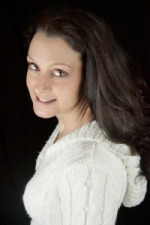 Lisa Dalrymple loves to travel and has lived in such countries as South Korea, Thailand and Scotland. She now lives with her husband and their three children in Fergus, Ontario. Her story, Skink on the Brink, won The Writers’ Union of Canada’s Writing for Children Competition in 2011 and is now a picture book illustrated by Suzanne Del Rizzo. Lisa is also the author of If It’s No Trouble… A Big Polar Bear and its sequel, Bubbly Troubly Polar Bear, coming in October 2013.
Lisa Dalrymple loves to travel and has lived in such countries as South Korea, Thailand and Scotland. She now lives with her husband and their three children in Fergus, Ontario. Her story, Skink on the Brink, won The Writers’ Union of Canada’s Writing for Children Competition in 2011 and is now a picture book illustrated by Suzanne Del Rizzo. Lisa is also the author of If It’s No Trouble… A Big Polar Bear and its sequel, Bubbly Troubly Polar Bear, coming in October 2013.
Where to find Lisa online: Website - Facebook
 Suzanne Del Rizzo loves the squish of plasticine between her fingers. Her illustrations appear in Skink on the Brink (Fitzhenry & Whiteside Spring 2013), written by Lisa Dalrymple. Her cover illustrations appear in the YA novel The Ehrich Wiesz Chronicles: Demon Gate ( Fitzhenry & Whiteside, Fall 2013) written by Marty Chan. She lives in Oakville Ontario with her husband and four children.
Suzanne Del Rizzo loves the squish of plasticine between her fingers. Her illustrations appear in Skink on the Brink (Fitzhenry & Whiteside Spring 2013), written by Lisa Dalrymple. Her cover illustrations appear in the YA novel The Ehrich Wiesz Chronicles: Demon Gate ( Fitzhenry & Whiteside, Fall 2013) written by Marty Chan. She lives in Oakville Ontario with her husband and four children.
Where to find Suzanne online: Website - Twitter - Facebook (personal) - Facebook (professional)
About SKINK ON THE BRINK:
Stewie is a very special skink — he has a beautiful blue tail which gives him a superpower against his enemies. Stewie loves singing his songs and rhymes as he dashes around his home. But as he grows up his beautiful blue tail starts to turn grey — he can't call himself Stewie the Blue anymore! And without his rhymes, his home by the pond doesn't feel as special either. A new Tell-Me-More Storybook about self-esteem, change, and growing up. Includes non-fiction back matter with bonus information and activities.
See the Fitzhenry & Whiteside SKINK ON THE BRINK page for supplemental materials created by Lisa and Suzanne, including coloring pages, activity pages, word searches, and more.
For lots of photos of Suzanne's amazing plasticine-illustration process, read further down in the interview.
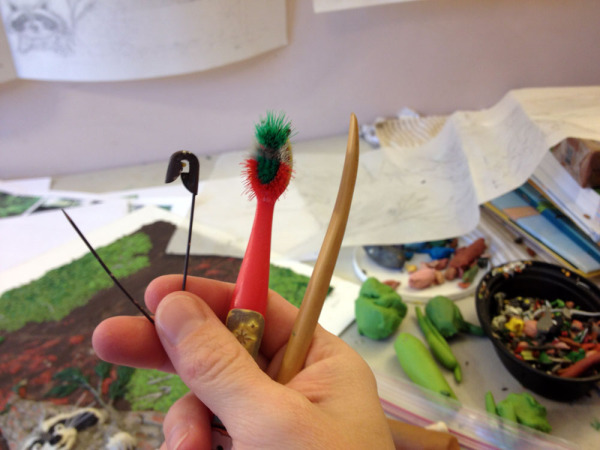 A few of Suzanne's plasticine carving tools. Read further for lots of photos of how she created the amazing illustrations in SKINK.
A few of Suzanne's plasticine carving tools. Read further for lots of photos of how she created the amazing illustrations in SKINK.
Q. What was your publication process for SKINK ON THE BRINK?
Lisa:
I actually can’t remember when I first started researching and writing the manuscript, but I think it was sometime around 2008. (It usually takes a couple of years for me to develop and craft a picture book story until it is finally submission ready.) During this time, I was also working on other books and I was trying to learn the ropes of the publishing industry by getting out, meeting other writers and professionals, and attending trade shows, festivals, etc.
 Christie Harkin, editor at Fitzhenry & Whiteside. Photo from Cynsations interview.In September 2010, I went to Word on the Street in Toronto. I remember that it was first thing in the morning that I saw Christie Harkin, the kids’ books editor at Fitzhenry & Whiteside, getting their booth ready for the day. I knew I wanted to talk to Christie, to find out what she was looking for in a manuscript and to establish a personal connection. However, first I had to walk around for a while to try to summon up the nerve. When I finally did, it was the end of the day and Christie was packing up her supplies to go home! She told me that she was developing a line of “Tell Me More” storybooks. In these books, while the story is, of course, the most important element, there’s also an additional educational component that can be more fully explored in the non-fiction back matter. We both agreed that Skink on the Brink might be a good fit for this line and that I should send it to her.
Christie Harkin, editor at Fitzhenry & Whiteside. Photo from Cynsations interview.In September 2010, I went to Word on the Street in Toronto. I remember that it was first thing in the morning that I saw Christie Harkin, the kids’ books editor at Fitzhenry & Whiteside, getting their booth ready for the day. I knew I wanted to talk to Christie, to find out what she was looking for in a manuscript and to establish a personal connection. However, first I had to walk around for a while to try to summon up the nerve. When I finally did, it was the end of the day and Christie was packing up her supplies to go home! She told me that she was developing a line of “Tell Me More” storybooks. In these books, while the story is, of course, the most important element, there’s also an additional educational component that can be more fully explored in the non-fiction back matter. We both agreed that Skink on the Brink might be a good fit for this line and that I should send it to her.
 Suzanne and Lisa do a signing with Michael Martchenko & Loris Lesynski at Toronto's Word On The Street
Suzanne and Lisa do a signing with Michael Martchenko & Loris Lesynski at Toronto's Word On The Street
There was a long period where I heard nothing, but I was getting used to no response if an editor really wasn’t interested. By the time February 2011 rolled around, I had completely given up. I went with a group of friends to the OLA Superconference in February and some of them stopped by the Fitzhenry & Whiteside booth to say ‘hi’ to Christie. When she noticed my nametag, she said, “Hey! You’re the skink lady!” I’d never been so excited to think that she remembered me and my manuscript. We had a “pre-editorial” discussion right there and I went home to create yet another draft of the book I’d now been working on for three years.
 When April 2011 rolled around and neither of the books I had under consideration with two separate houses had yet acquired that elusive “yes,” I submitted them both to the Writing for Children competition hosted by The Writers’ Union of Canada. This competition receives between 600-800 entries each year and I submitted every year so, of course, I had no real expectation that I would win.
When April 2011 rolled around and neither of the books I had under consideration with two separate houses had yet acquired that elusive “yes,” I submitted them both to the Writing for Children competition hosted by The Writers’ Union of Canada. This competition receives between 600-800 entries each year and I submitted every year so, of course, I had no real expectation that I would win.
But then there was a day, the same day that I heard from Tuckamore Press that they were ready to send me a contract for my book If It’s No Trouble… A Big Polar Bear, when the phone rang and Nancy MacLeod informed me that Skink on the Brink had won the competition – and that I was sworn to secrecy for almost a week! By this point, Christie and I had a friendly relationship and I think it may have been my post on Facebook, “This is one of the most exciting days of my life,” that prompted her to get in on the excitement and send me my first official book contract!
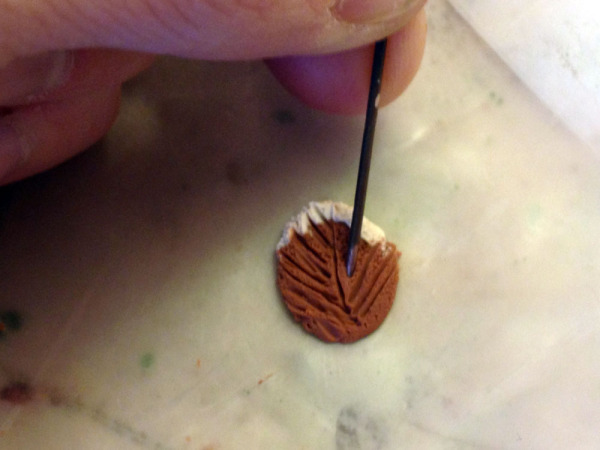 Suzanne adding detail to one of her illustration elements. Wow.
Suzanne adding detail to one of her illustration elements. Wow.
In October 2011, we signed the contract and Christie let me know that they were considering Suzanne Del Rizzo to illustrate the book. She sent me a few samples of Suzanne’s work. Of course, I was thrilled! Suzanne’s plasticine artwork is beyond anything I would have imagined for Stewie and his story and I was so excited to see it finally start coming to life.
In January 2012, Christie and I got started on the ‘first round’ of edits, which actually became the ‘never-ending round’ of edits as we kept passing the manuscript back and forth, trying to get some of the rough spots ‘just right’ so that Suzanne could get started.
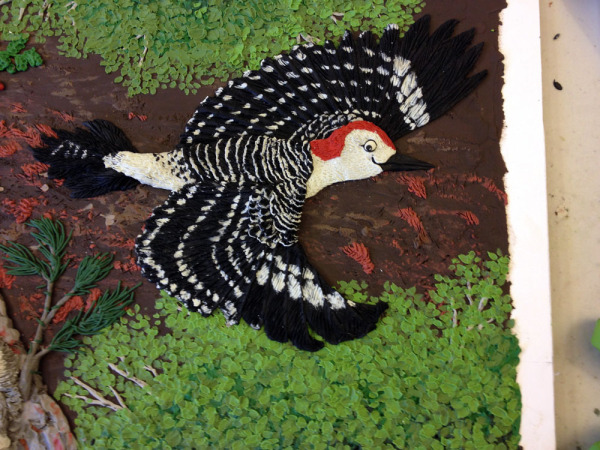
And then the real fun began. I was so excited that Suzanne would consult with me about the illustrations. Her artwork was fabulous and she wanted to check in with me from a research perspective. We both wanted to make sure that we were using our combined knowledge to make sure that the book was as biologically accurate as possible.
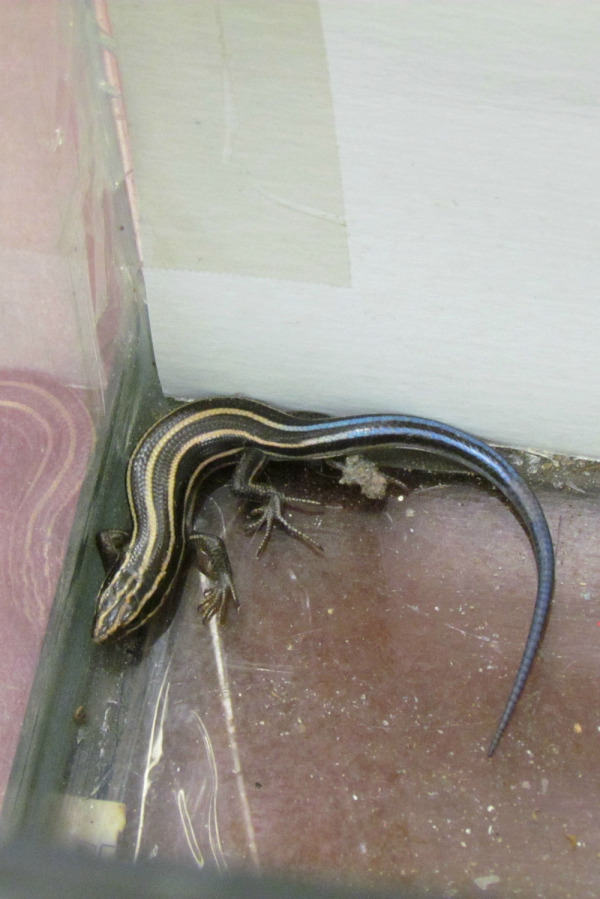
Once the artwork was done, in January 2013, I received the ‘final round’ of edits from Christie and the book went to the printer. Then, in May, Suzanne and I were able to drop by the Fitzhenry & Whiteside office to finally hold the finished book in our hands!
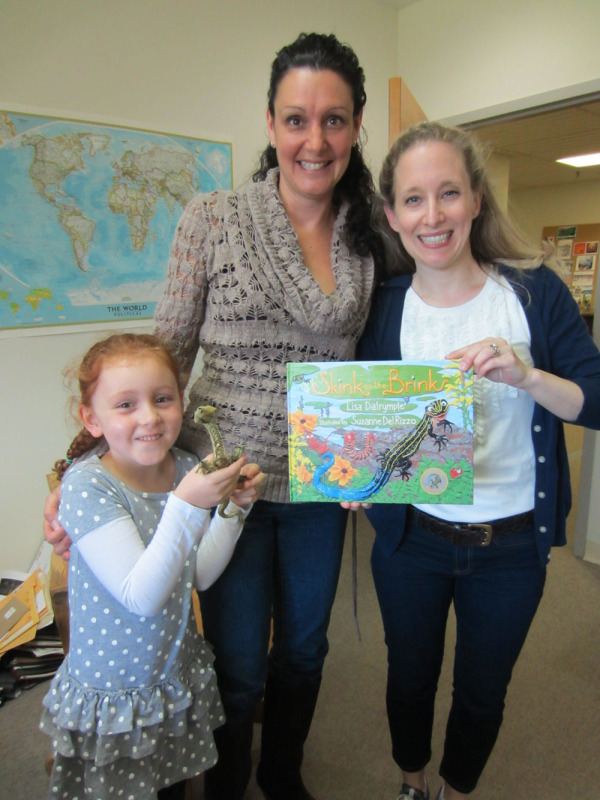
Q. What was your writing/illustration process for SKINK ON THE BRINK?
Lisa:
I wish I could say I have a process that indicated some sort of routine but, working from home for the past few years with small kids around, any routine has been pretty hard to establish. I’m hoping this will improve when my youngest daughter starts school fulltime this year because I know how important it is to have that dedicated writing time. 98% of writing is pure hard work – just keeping that butt in your chair and working, preferably with few to no interruptions! Sure, there’s that other 2% of writing that’s genius inspiration, where the brilliant ideas come to you (usually in the shower) and you hop out, words already flying from your fingertips. That kind of writing can be done almost anytime, anywhere (although I would recommend getting out of the shower first.) But the other 98% is very difficult to do when there are so many demanding distractions of family life and when we all know how tempting it is to give in to distraction in the first place.
At the same time, my kids make huge contribution to my writing process. Getting their input and ideas, as I’m crafting a story is an invaluable part of the process for me. I can’t tell you how many years we’ve spent out in the wilderness on family camping trips, pretending to be skinks and shouting things like “I’m Stewie the Blue” over the pond – and how informative and inspiring it is to see how kids engage with your story when it’s still all coming together in your mind.
Suzanne:
My process for this book began with lots of research. I must admit, I’d never heard of a skink before reading Lisa’s manuscript, so I had some homework to do before I even put pencil to paper. I researched all I could online and from books, and took photos at my cottage (which falls within the geographical region of the Common Five-Lined Skink’s habitat) to create a massive photo reference file:
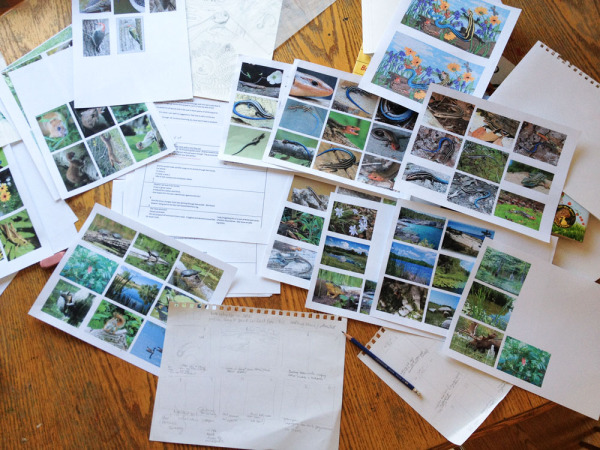
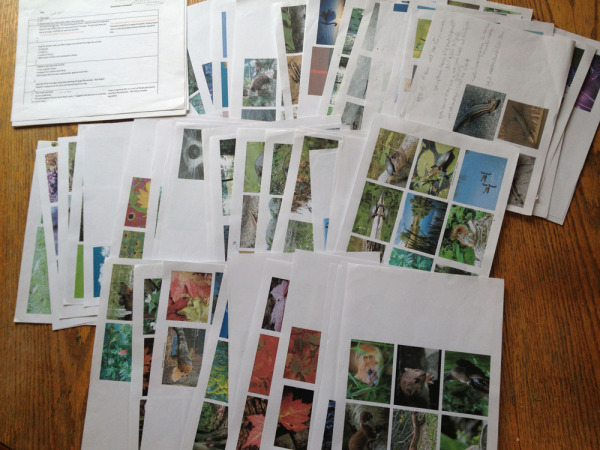
Lisa also provided me with some great shots she had taken while at The Pinery Park where she had seen a Common Five-Lined skink up close. Stewie the skink would be undergoing both physical growth and coloration changes throughout the story, and because this was also a Tell-Me-More story book with accompanying cross-curricular back matter; I wanted to ensure I was maintaining as much biological accuracy as possible.
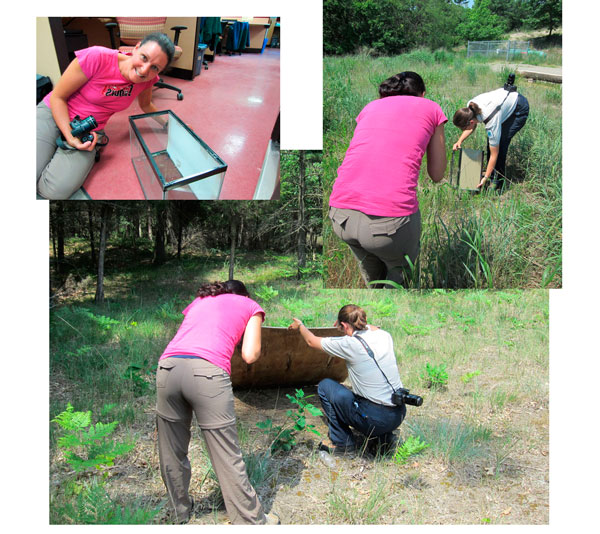
I envisioned having lots of secondary animals and vegetation to make Stewie’s habitat rich and authentic, so I also needed to familiarize myself with the various animals and plant life that co-exist in his habitat. I then created some sample art for Christie to show at the sales meeting, and after landing the contract, I began thumbnail sketches.
Christie encouraged Lisa and I to get in touch and bounce ideas around. It isn’t always standard for authors and illustrators to discuss a project, but in this case, I think it really helped us achieve something special with this book, it was a fantastic collaboration. It even led to some hilarious “oops” moments...like the time when I made a minor flub and put a moose in one illustration... moose don’t extend quite this far south- oops. Luckily Lisa caught it and it was easily changed to a white-tailed deer. If you look closely on my full- sized sketch:
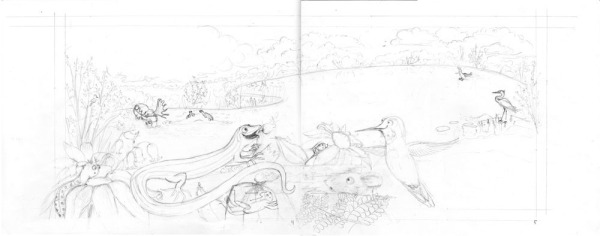
...you can see the moose, yet in the final plasticine illustration it has been changed to a white-tailed deer:
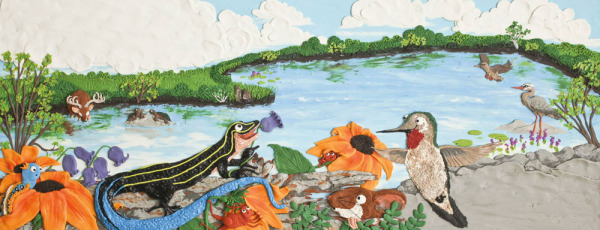
Once thumbnail sketches were approved I worked up full-sized tight pencil sketches:

Because I work in plasticine, I prefer to create very detailed, tight pencil drawings to show my editor, and ideally make changes at this phase of the project. Each plasticine illustration can take from 20-40+ hours to create, depending on its size and complexity, so it’s much easier to erase a few pencil strokes at this point then to peel off/redo the plasticine final art.
My illustrations are essentially low relief sculptures created in plasticine(modelling clay) and pressed onto illustration board. The final plasticine art is then professionally photographed:
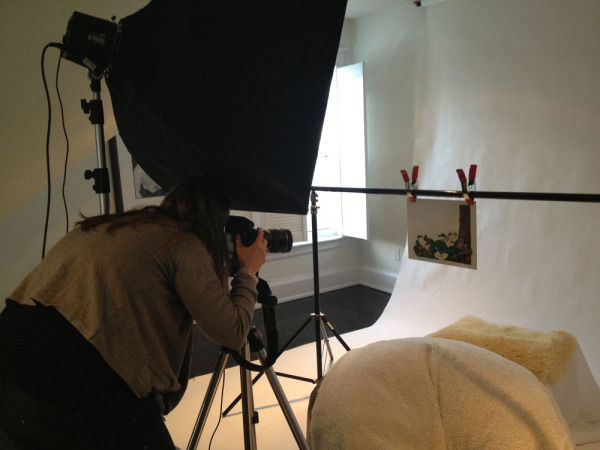
Before I started any final art I premixed the colours, after some initial colour studies, to create a colour chart:
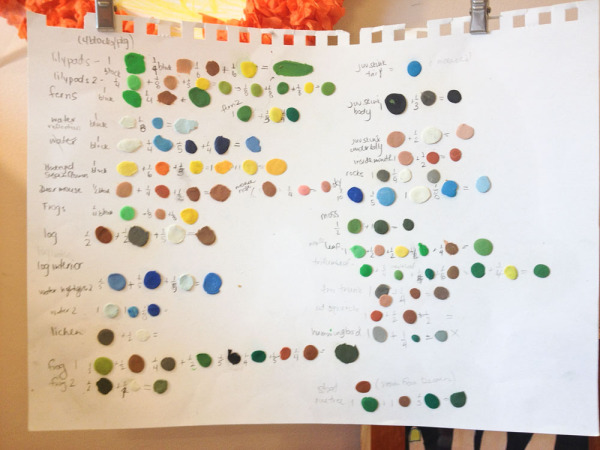
I hang this next to my sketch for quick reference. Then I made up large amounts of my colours so I’d be able to maintain consistency throughout the illustrations. This type of chart comes in handy if I run out of a colour and need to make more. To begin each illustration, I’d smear on plasticine in a thin layer to create the background, then gradually build up and add on, then move onto foreground objects as I go:
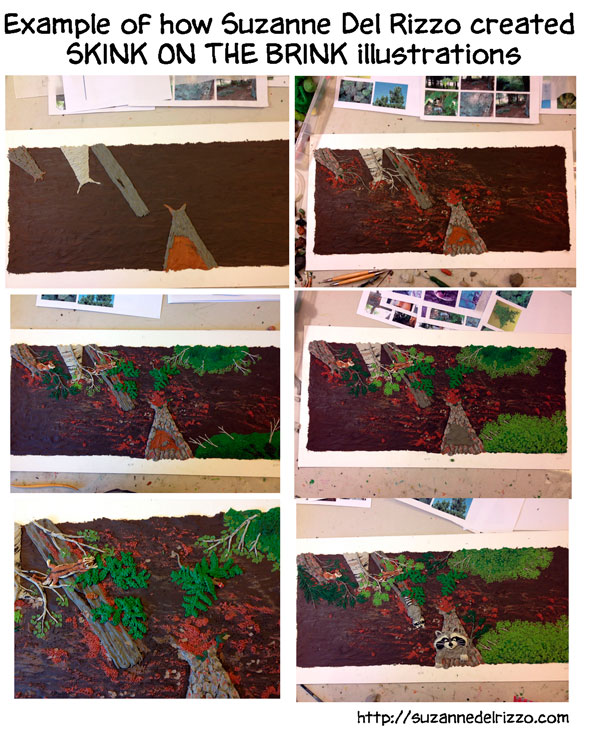
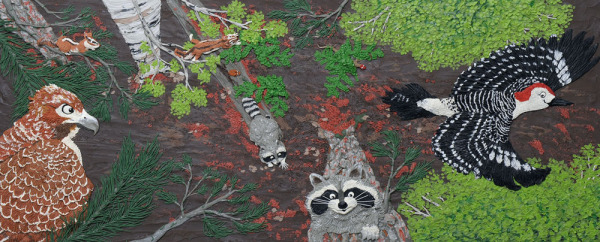
(From Debbie: click here for a close-up look at some of the detail in the final illustration)
One of my favorite parts of any illustration is adding the final textures and details to really bring life to the piece. I use a variety of clay sculpting tools but often times I end up using my good ol’ favorites-a large safety pin, toothbrush, toothpick and my fingers. Sometimes I even make my own tools. For Stewie the skink, I made a selection of polymer clay tools that make impressions of reptile scales:
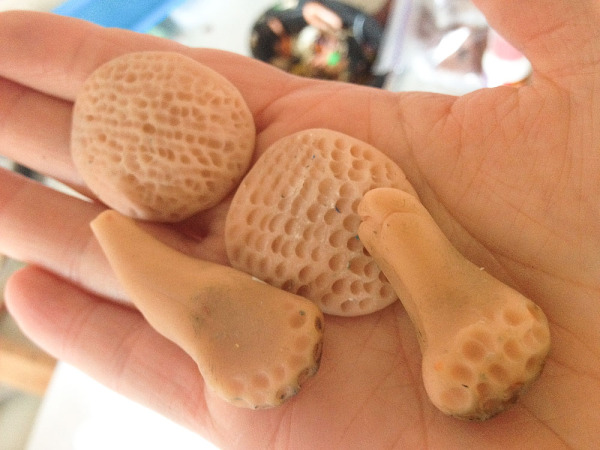
then I used an acrylic gloss to make him glisten.
For intricate parts, I sometimes worked on top of a Ziploc bag that I’d place directly over top of my sketch:
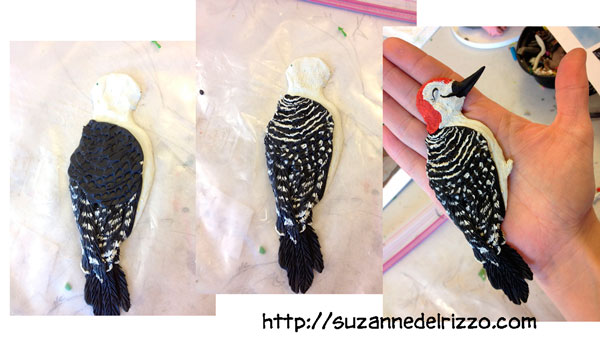

(Note from Debbie: Click here to see details in a bigger version of the woodpecker)
Then I could check to ensure that my sculpted objects were the correct size- plasticine has a tendency to spread and flatten as you work with it, which can be frustrating. So I kept a bowl beside me for my “rejects”...and believe me there were plenty. Faces are especially tricky to get just right. But that’s the great thing about plasticine- it never hardens, so you can just peel off the offensive bits and smoosh ‘em, and start afresh. My kids like to raid the reject bowl (as they call it) and put these bits to use in their own creations.
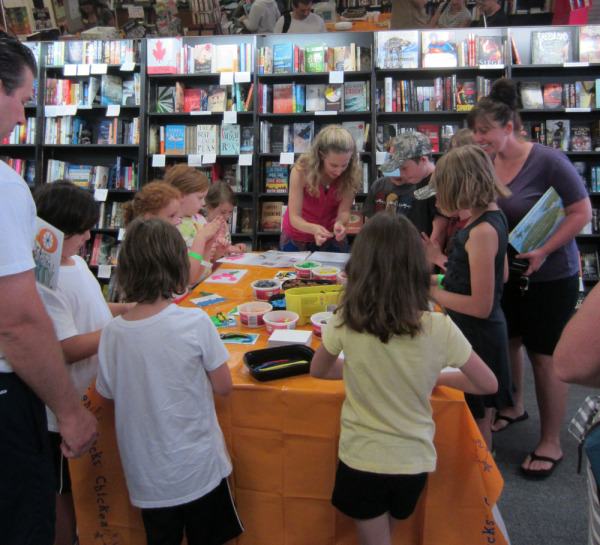
Having a little kiddo sitting next to me on the floor, working on their own plasticine is one of the best perks about having my art studio in my home. Kids are also the best source of inspiration.
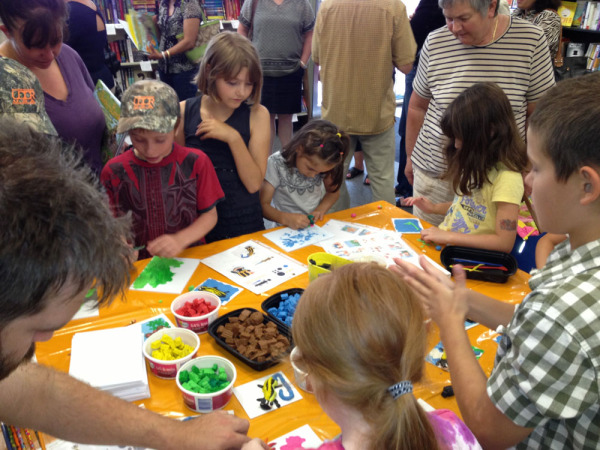
Q. What advice do you have for aspiring children's book writers and illustrators?
Lisa: There is so much important advice out there given by far more experienced writers than me – but you’re not going to hear any of it if you’re sitting in your house staring at a cursor on a screen...
Suzanne: ...or working away in your art studio. And I’m even more “green”, LOL but I am always happy to share what I have found helpful on my pursuit to publication.
Lisa: Get out there and meet other writers and creators. The camaraderie and support of a network of peers is invaluable – for information sharing, providing a shoulder to cry on (or a glass to clink with), for forming critique groups and for gaining access to all that wonderful advice.
Suzanne: Yes, you said it Lisa! We creative types tend to be an introverted lot, but it’s so important to put yourself out there and meet others, connect, share ideas and soak up advice from more seasoned author/illustrators. I have found this community of author/illustrators, both online and in person, to be extremely supportive and encouraging
Lisa: In Canada, some good places to start are organizations for children’s writers such as CANSCAIP and the Canadian Children’s Book Centre (CCBC). Internationally, look into the Society of Children’s Book Writers and Illustrators (SCBWI). Any festivals, trade shows or signings in your area that have anything to do with books can also be useful places to connect with other writers or industry professionals.
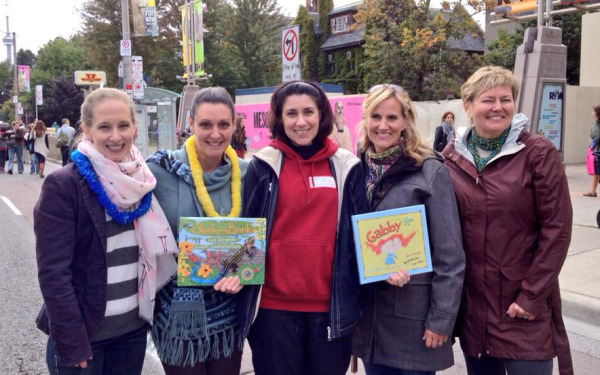 Suzanne and Lisa with their editor Christie Harkin (in red shirt) and friends Jan Dolby & Joyce Grant at Toronto's Word On The Street
Suzanne and Lisa with their editor Christie Harkin (in red shirt) and friends Jan Dolby & Joyce Grant at Toronto's Word On The Street
Suzanne: The thought of attending a large conference might be utterly terrifying if you are just starting out, so start small. Check out the monthly CANSCAIP meetings, or go to Word on The Street and mingle at your pace, or hop online and get to know the Twitter and Facebook community of illustrators and kidlit writers. I must admit to having a bad case of “imposter syndrome” when I first made the career switch from working in a science research lab, after all I didn’t have an art degree. Could I make a go of it as children’s book illustrator? I decided to be brave and just go for it. The self doubt still creeps up on me some days. But I had to start somewhere. Those first small steps, attending meetings and making initial connections paved the way to bigger conferences and helped me gain my footing as an illustrator.
Joining a critique group is invaluable. We often work in a bubble, isolated, “in the zone” creating, be it painting, sculpting or typing away the hours on our tread-desk. We tend to be our toughest critics which can often lead to self-doubt or worse still the dreaded “analysis paralysis”. Crit groups will not only help you grow as an artist, by pushing you in a direction you may never have considered on your own, but they also give valuable, honest criticism of your work and provide a safe environment to share new ideas, ask those silly questions, and learn about the industry. I belong to a few crit groups, one of illustrators, and another of authors and author/illustrators. Authors and illustrators look at manuscripts (and artwork) from a different perspective, and it can be very helpful to get both types of input, especially if you are interested in writing and illustrating, as I am.
Lisa: A critique group is really important. Even if your writing is already awesome, there is so much to be learned from seeing other perspectives on your work. Engaging with other people’s stories when offering a critique has taught me to see my own work with a more critical eye and helped me to develop further focus and direction in my own writing.
Suzanne: Like I mentioned above, get online and make connections. Joining Twitter, and Facebook is one place to start. Every Thursday at 9pm EST there is a Tweet Chat of kidlit creators, just follow #kidlitart, and check it out. They are a welcoming and fun bunch. Zero2illo is another fantastic resource I found extremely helpful when I was starting up my illustration career. It has many great resources, from setting up your portfolio website to designing a business plan. I also belong to their zero2illo confidential, a crit group of sorts but so much more.
Lisa: If anyone reading this has any further questions, or would like direction to an online critique group for serious children’s writers, they can feel free to contact me through my website. (www.lisadalrymple.com)
Suzanne: Yes, please contact me through my website (suzannedelrizzo.com) if you have any further questions.
Q. What are both of you working on now? Any other upcoming events or other info you'd like to share?
Lisa:
Suzanne and I have decided to dub the past few months “the Summer of the Plasticine Road Show.” We’ve been taking Skink on the Brink and Suzanne’s fun and interactive plasticine workshops to events all over southern Ontario. For the fall, it looks like the Plasticine Road Show lives on! We were recently at Toronto's Word On The Street; I will be at the Family Resource Centre in Peterborough on September 28th, followed by a signing at Peterborough Chapters; we will be taking part in the Creemore Arts Festival on October 5th.
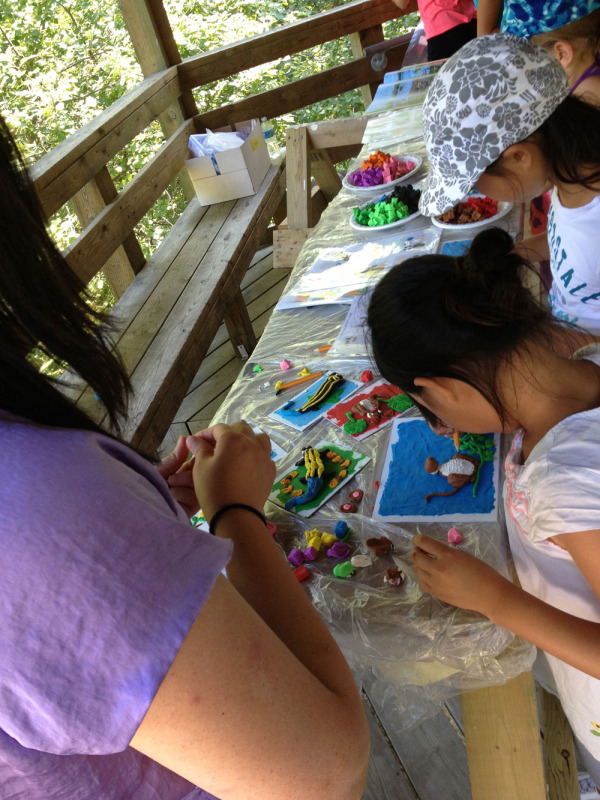
As for what I’m working on now, my third book, Bubbly Troubly Polar Bear, is due out with Tuckamore Books in October 2013.
I’m also very excited about a picture book with a multicultural theme that I’m working on, in which a young Canadian girl travels around the world with her archeologist parents. Through attending school in Thailand, Peru, Jamaica, Scotland and South Korea, she participates in both the differences and the similarities of daily life. I’m hoping to have her experiences to show, through an eight-year-old's eyes, that, while there are many diverse cultures, there can be a common understanding in the sharing of music, food or something as universal as a game of Hide & Seek.
Suzanne:
As for me, I just finished a project for a YA novel cover for The Ehrich Wiesz Chronicles: Demon Gate (Fitzhenry and Whiteside, Fall 2013) by Marty Chan. I created the front and back of a steampunk medallion/Infinity Coil in polymer clay and watch components. I also have another Tell-Me-More storybook project in the works with Fitzhenry and Whiteside. I’m working up some of my manuscripts into picture book dummies for submission as well.
Q. How did your book launch go? And how has reception to SKINK ON THE BRINK been so far?
Complete with plasticine activities and a skinktastic chocolate cake:
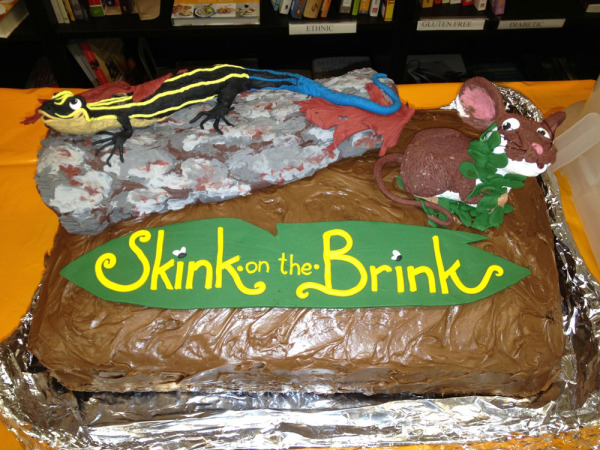
the official launch of Skink on the Brink was at Story Planet in Toronto, but this summer has actually been a series of exciting launch events. We held a second launch at Roxanne’s Reflections, in my current hometown of Fergus and it was every bit as much fun as the first! Then our favourite event this summer was definitely introducing Skink on the Brink to the Pinery Provincial Park at their annual Savannah Festival.
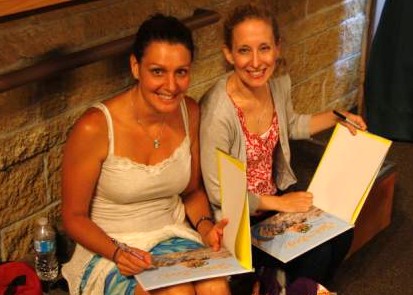
The Pinery is one of the few places in Canada where the Common Five-lined Skink can be found and it’s the area that inspired the character of Stewie and his story. There was something really special about reading Skink on the Brink right in Stewie’s natural habitat and then working with the kids on their terrific plasticine creations on the very veranda where he’s known to hang out and bask.
The kids at all of our events have been tons of fun to work with and incredibly excited – especially those who managed to catch a glimpse of a real Five-lined Skink in the wild, and Suzanne and I now both have households full of plasticine critters! But the best part is definitely hearing the kids’ enthusiasm for conservation efforts and for protecting skinks and their habitat.
------
For more interviews, see my Inkygirl Interview Archive.
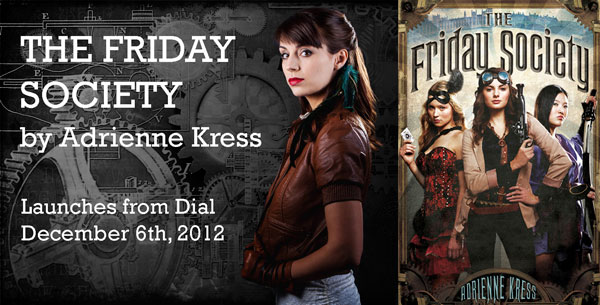 Photo of Adrienne: Tanja Tiziana. Steampunk background: http://valerianastock.deviantart.com
Photo of Adrienne: Tanja Tiziana. Steampunk background: http://valerianastock.deviantart.com
I met Adrienne Kress through the Toronto MG/YA Author Group (Torkidlit). She's smart, funny and passionate about her craft, and I've appreciated her advice and encouragement over the years. I interviewed Adrienne about her middle grade novels last year, and I can't wait to buy her new YA steampunk novel, THE FRIDAY SOCIETY (Dial, Dec/2012). More info on her website: AdrienneKress.com.
If you're in the Toronto area, I encourage you to go to Adrienne's book launch on Fri. Dec. 7th at the Gladstone Hotel. Check out this VERY cool event launch poster (click to see the bigger version):
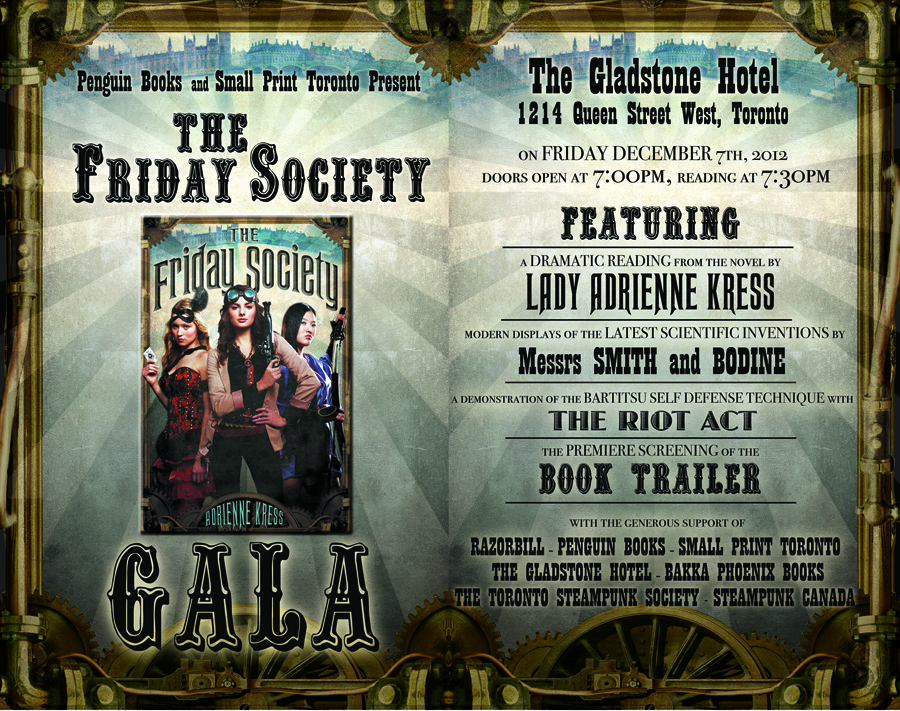
Summary of the plot from a starred Quill & Quire review of THE FRIDAY SOCIETY: "The steampunk adventure novel, set in Edwardian London, follows the lives of three very different teenage girls, each of whom works for an important man but also maintains a life of her own. The three strangers – Cora (the lab assistant), Nellie (the magician’s assistant), and Michiko (the Japanese fighter’s assistant) – find themselves thrust together as the result of a horrific unsolved murder and quickly discover that, by combining their special skills, they can accomplish more than they ever thought possible."
Above: BookEnds interviews Adrienne about steampunk fiction, writing & THE FRIDAY SOCIETY.
Q. What was your creative process for The Friday Society?
The creative process for THE FRIDAY SOCIETY was very similar to the process for my writing in general.
It starts with thinking. Normally I get a cool basic idea. In this case it was a team of female Steampunk superheroes. Then I start to problem solve: how many should there be? Who are they? How do they meet? What is the basic plot that drives them? What are the supporting characters? Etc. The more I think, the more comes to me. It's all a bit of a logic exercise, "If they are like this, then this means that. If this is their job, that means that they probably live here. . ." and so on.
I really do just think about it for a good while. If the idea sticks with me, if it gives me butterflies still a week later, I take that as a sign that the idea has staying power. That's the key with writing for me. The act of writing is not glamorous. It's hard work. You aren't always inspired to write. In fact many days you feel a bit like a little kid who doesn't want to get up in the morning: "I don't wanna!!" So you need to have a project that you are completely passionate about. That you are willing to work through the rough patches for. At least I do.
Then comes figuring out the voice. This usually begins by jumping into the deep end and just starting writing. For THE FRIDAY SOCIETY it took a bit more effort than usual coming up with the voice. I started out writing it oldy-timey - a bit like the voice I used in my short story in the anthology CORSETS & CLOCKWORK - but it didn't really suit the light irreverent tone I was going for. Eventually the idea of writing the book in a contemporary voice came to me, and it made SO much sense. After all, the key to Steampunk is that it is anachronistic - a story set in the past but with futuristic technology and attitudes. Well why couldn't the actual act of telling the story be anachronistic too?? (if you want to read a post on the subject of anachronisms in Steampunk and why I chose the voice I did, check out my blog here). Once I had the voice, I could really get going on the story.
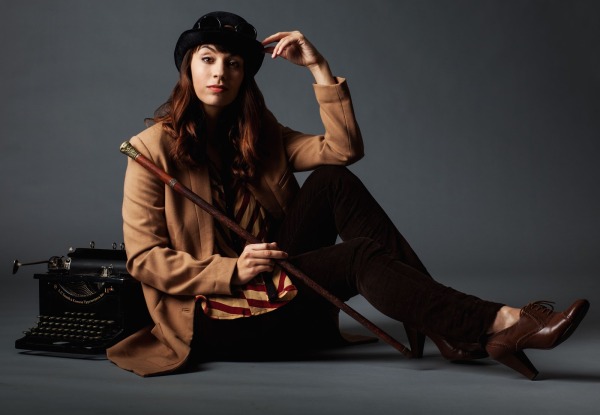 Photo: Tanja Tiziana
Photo: Tanja Tiziana
Now back when I was younger when I wrote just for fun, I realised I was the kind of person who enjoyed starting to write and seeing where the story took me. If I planned something out too much I got bored. I would feel, "Well, I already know what happens, what's the point in me writing it?" But I quickly learned that if I didn't do any planning whatsoever I would paint myself into a corner that I just couldn't get out of. So what I tend to do is a combination of both. I come up with a very basic plan, and then I fill in the blanks in the moment as I write. I also tend to plan in phases. So I'll plan the first fifth of the book, and when I'm coming to the end of that, I'll stop and plan the next fifth. Etc. As an example: with the beginning of THE FRIDAY SOCIETY I decided I wanted three chapters of introductions per girl and then I wanted my girls to meet up at a gala where they would come across . . . something mysterious. Seriously, that was it. Not much to go on, but still enough that I knew where I was going.
I should add at this point that I do tend to have a very basic idea of what the novel will be on the whole. This is part of what I think about during the thinking phase. But again it's very basic. In the case of TFS it was, "I want a Steampunk superhero origins story where my three girls defeat someone intent on destroying London for some reason. Also there will be subplots." :)
As I continue to write my book I, of course, come across bumps in the road and face difficult problem solving. This is always tricky to manage but I have learned that if I just stick with it I can get out to the other side. Sometimes it means moving onto something else or just going for a walk to clear my head. Sometimes it means sitting there and figuring it out one word at a time. And it's kind of amazing the direction your brain can take you. The characters of Hayao and Dr. Mantis were meant to be small one offs, but as I wrote them they just took on a life of their own and became integral to the story. This is why I enjoy not planning every little thing as I write, I love being surprised by my own story.
Now my method is simply mine. It certainly does not work for everyone. The most important thing is for a writer to find what works for him/her and be confident in that technique. So many blogs will tell you absolutes. But here's a secret: whatever works for you, works for you. Try different methods, see what sticks and discard that which doesn't. Don't be afraid to fail, and don't second guess when something is working for you.
Q. What advice do you have for aspiring writers?
Unfortunately my advice in not particularly glamorous nor original. It is: Read and Write. Ta da! To elaborate. . . Read. Read a lot. Read every genre and every medium. Read novels, non-fiction, plays, poetry, graphic novels, picture books etc etc and so forth. Everything you read will inform what you write. It will teach you the writing rules, it will teach you how to break those rules. It will teach you what you like, it will teach you what you aren't a fan of.
And then you have to write. You just have to write. A lot. You never really learn until you do. And you never really improve until you do a lot.
Q. Any upcoming events or current projects you'd like to share?
Well, the book launch for THE FRIDAY SOCIETY is this Friday at The Gladstone Hotel in Toronto.
I am also doing a Steampunk event at Words Worth Books in Waterloo on December 12th with the wonderfully talented Morgan Rhodes (author of the upcoming FALLING KINGDOMS).
Related links where you can find more info about Adrienne:
Adrienne Kress media kit
Adrienne Kress author website (Adrienne's also an actor, director, playwright & teacher)
On Twitter: @AdrienneKress, on Facebook
Inkygirl interview with Adrienne last year
Review of THE FRIDAY SOCIETY by Quill & Quire, Steampunk Canada
Some related interviews:
Avery's Book Nook: "The Friday Society" by Adrienne Kress
The Friday Society: A Chat with Adrienne Kress (The Book Smugglers)
Manga Maniac Cafe interview with Adrienne



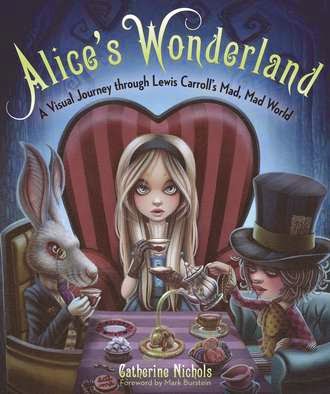








































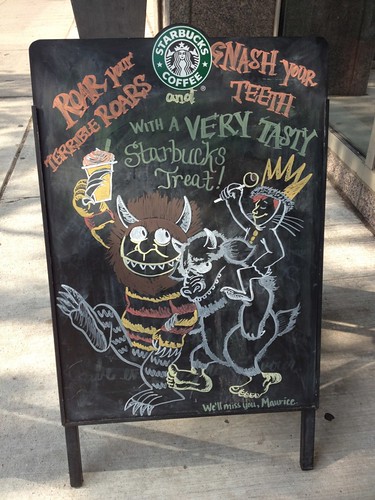









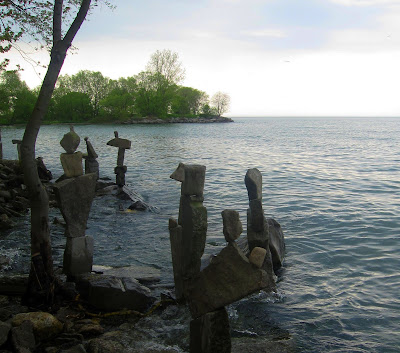
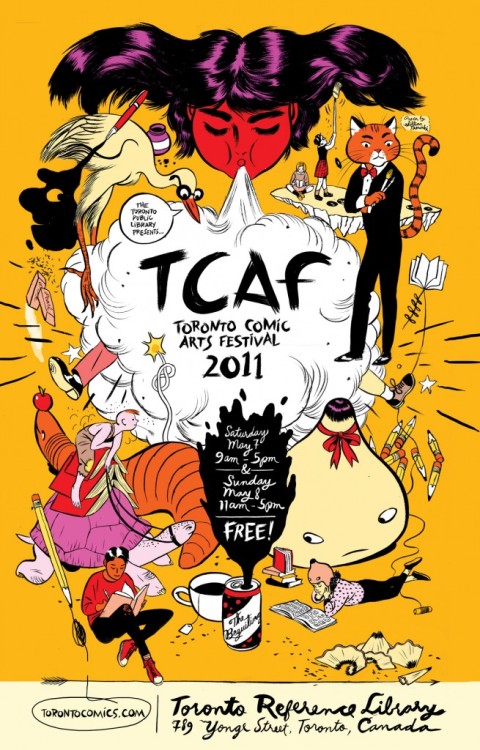





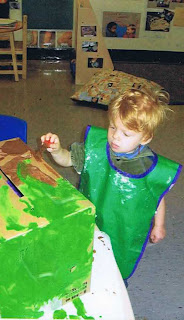

Well I envy you if you can go to Nova Scotia! If it were me, I think I'd approach Canada via the historical angle. The Viking site at L'Anse aux Meadows, and the history of the Native Americans, and the French arrivals and then the Scottish - and the various alliances and battles.
I agree it's a huge country, and difficult to make sense of from a distance - but I'd love to go to Quebec and Montreal... I've been to Toronto several times as my sister used to live there. There's a lovely board walk along the shore, and it feels different from an American city - the French influence is quite obvious, and of course all the signs are dual language, and all the distances are in kilometres...
So I hope you have fun! I'll look forward to your blog! :)
As a Torontonian now living in Germany, I found this a fascinating post.
It is hard to get one's head around "Canada" even for a Canadian. I think that's why most seem to identify strongly with the region they come from. The fact that most Canadians are relatively new to that land also affects the essence of what it means to be Canadian: it's a slightly amorphous thing, not like what it means to be British or German or just about anything else. And it's forever changing in the cities as the ethnic mix is in constant flux - making for a fascinating, dynamic identity, but a not-quite graspable one in its constant shape-shifting nature.
Don't be put off by those pictures of the Toronto skyline - one hardly ever sees the city like that, and then only from the islands - the city itself is made up of numerous neighbourhoods - each with its own very distinct character: Chinatown, Little Italy, Greektown where the signs are in English and the languages of the inhabitants and the food is incredible; The Annex with its Victorian Mansions and funky mix of university students and professors, artists and writers; Queen St. West with loads of art galleries and interesting pubs and restaurants...
British Columbia is gorgeous! The culture of the First Nations People is very strong there which I found fascinating and wish I could have spent more time there.
I'm with Katherine - envious if you get out East! I never made it to the East coast, but it's also supposed to be stunning with a fascinating regional culture and history.
I hadn't meant to go on like this - sorry! I do hope you have a good trip - full of adventure and discoveries. I look forward to reading more on your blog!
Thank you, Katherine and Lynn. You've both given me things to think about. Canadian history is something I know little about. I must remedy that. And as most of my time will be spent in the east, your bits about fascinating regional culture and history, not to say anything of stunning landscape, are most encouraging.
I'm sure there will be a blog. I can't bear the idea of travelling without writing it all down. I'll probably do the same as with my Belize travels and have a Canada blog button on my website, so do look out for it. I'm not going until September but as and when I find things that are interesting, I'll probably throw them all in.
A post like this makes one want to start packing. So happy to hear you are off on another travel adventure. I'll look foward to your blog.
I wasn't in Canada long but one of my most magical memories is of swimming in a lake in the summer with all the mountains around. That, and all the warnings about bears the Canadians enjoy giving you. You'll have great time.
One thing I found odd was the pattern of place names. Here the language patterns of the names often indicate the local history - Viking names in the north etc. However, in Canada you see UK place names scattered almost randomly across the map - though presumably where settlers settled. Takes some getting used to.
Penny - lake swimming sounds good to me. Just back from Pembrokeshire [see this coming Saturday's Authors Electric] where swimming definitely wasn't the order of the day - though it has been every other year, and I'm definitely missing it.
Lynn - thanks for your comments on the essence of being Canadian. It's just this sort of thing I want to hear. From now onwards, and throughout the trip, I'll be trying to get a better understanding of what 'being Canadian' is all about.
When I first moved to Shropshire, I arrived without roots. I was born in London and grew up there, but I never felt as if I belonged. Maybe my mother's alienation rubbed off on me - a Guernsey girl fleeing Hitler's army during the Second World War, she never felt at home in London, or indeed anywhere else. But thirty-five years after my arrival here, I now feel like a proud Salopian. It's living and breathing a place over time, I guess, that makes it yours - if you want it to of course And, as you're experiencing as a Torontonian in Germany, once you've got that it remains with you wherever you go.
I'm a Canadian living in the UK. I love both countries, both are beautiful and dear to me in different ways. Those vast roads you talk about, they are long, and journeying through the praries on the trans-canada highway is dangerous. It will feel like driving through a day and half of the same flat open space, it is hard not to fall asleep. Also, it is difficult even when you are a local resident to know when and where the next petrol (gas) station is. The signs in rural Canada are non existent. If they were ever put up in the first place, a snow plow probably knocked them down. That said, have an amazing time. The country is beautiful, the bears are not nearly so mean, the people will welcome you with open arms, and there is lots to do. Do please visit BC. Everyone goes to Toronto, but don't by pass Vancouver, or better still go to Victoria! (Perhaps my west coast roots are showing.) I've lived in five different provinces, and each have something worth seeing. I am sure you will be happy to be home, as I am, when I return to the UK. There is so much unsung about the wonderfulness that is living here! Canadians love breakfast, it's a thing, so make sure to hit an IHOP, or TimHorton's while you are out there. There is many quick, but tasty breakfasts that I do miss. I could ramble all day, but if you want any local info, just email me. Places like Cultus lake, Whistler, or Harrison rarely get a mention in travel books, but are well wroth the journey.